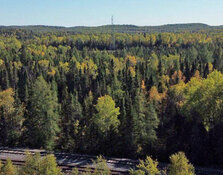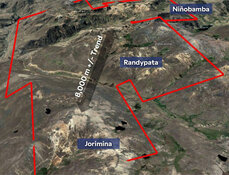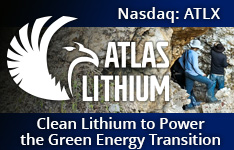Dakota Gold Corp. (DC:NYSE American) had its target price boosted 45% by Canaccord Genuity as a result of updating its model on the U.S. gold explorer, reported Analyst Peter Bell in a June 3 research note. Dakota is advancing the Homestake District, encompassing the Homestake and Richmond Hill projects, in South Dakota's Black Hills.
"We reiterate our Speculative Buy rating on Dakota Gold," wrote Bell.
Canaccord's new target is US$12 per share, up from US$8.25 previously. In comparison, the gold explorer was trading at about US$3.16 per share at the time of Bell's report. From this price, the return to target is 280%.
Junior gold stocks recently started outperforming the majors, and the majors have been outperforming gold, Brien Lundin pointed out in Gold Newsletter. "This is precisely what we want to see and validates my recent comments that this next leg upward in gold will see the junior mining stocks finally make their big moves," he wrote.
Along with its latest commodity price forecast, Canaccord also included in its revised model on Dakota the latter's 2024 financial results, recent equity financing and updated Richmond Hill mineral resource estimate. The revised MRE was ready in less than a year of the maiden version being released, Bell noted.
"Richmond Hill is an important component of Dakota Gold's exploration strategy for the Homestake District," wrote Bell.
This property contains the past-producing Richmond Hill mine and the Carbonate District mines. It is north of Coeur Mining Inc.'s (CDE:NYSE) Wharf mine and like Wharf, generally hosts Tertiary Age mineralization. Gold occurs in breccia zones.
Richmond Hill's current global resource, heap leachable and mill, is 721,900,000 tons (721.9 Mt) of 0.42 grams per ton gold (0.42 g/t Au), containing 9,600,000 ounces (9.6 Moz). This represents a 294% increase in contained gold from the prior MRE. The heap-leachable resource, Canaccord's focus, Bell wrote, now is 6.3 Moz of Au, up from 1.7 Moz, though lower grade.
"In our updated mine model, we assume a conversion of 90% of Measured & Indicated and 70% Inferred," wrote Bell.
The updated MRE encompasses two sets of drill data. The historical set contains 56,734 gold assays from 902 holes drilled over 90,447 meters (90,447m). The modern set encompasses 30,743 gold assays from 146 holes, over 45,540m, drilled by Dakota since 2022.
A Fresh Project Scenario
The updated model led to Canaccord's new conception of a potential mining project at Richmond Hill, noted Bell. Now Canaccord envisions a standalone, open-pit, heap-leach operation based on a resource of 382 Mt of 0.42 g/t Au, for 5.1 Moz. Before the MRE update, Canaccord, in its base case scenario, assumed a 4.49 g/t Au underground resource, about 2.96 Moz between Richmond Hill and Maitland.
Canaccord's model forecasts Richmond Hill processing 18 Mt of ore per year for average annual production of 174,000 ounces of Au per year over a 21-year life of mine. Life of mine cash costs are $856 per ounce ($856/oz) of Au and all-in sustaining cost is US$1,014/oz of Au. Initial capex is estimated at US$400 million ($400M), 60% of which Canaccord projects will come from debt, the other 40% from equity.
"Following these changes, we value Dakota's Richmond Hill project at US$2.531 billion (US$2.531B)," wrote Bell. "We project a one-and-a-half-year build starting in 2028, with production to begin in the back half of 2029."
Also in its model, Canaccord maintained its conceptual Maitland mineral resource of 13.48 Mt at 4.59 g/t Au, for 1.99 Moz. The investment bank valued the Maitland project, in situ, at US$175M and regional exploration at US$73M.
Juniors About to Make Move
What we have seen so far with gold is just the start, and "the best is yet to come," purported Technical Analyst Clive Maund in a June 1 note. We now are at the early stages of "what looks set to be a really big and powerful upleg" that commenced on May 14, when gold was at its intermediate low.
Brien Lundin of Gold Newsletter is of the same opinion, that the next rally in gold has started. This, he wrote on June 4, is evidenced on the charts by it breaking through the pennant formation that has been developing since the correction began in late April.
This year so far, gold has continued its 2024 outperformance, with the gold price already having burst through new all-time highs, wrote Stuart Fieldhouse, The Armchair Trader, on June 5. Key ongoing drivers include the expectation for further Federal Reserve easing later this year and U.S. President Donald Trump's trade policies, including the reintroduction of tariffs and related conflicts. Decreased confidence in the U.S. dollar is another contributor, due to trade and foreign policy volatility and rising concern that the new Administration's policies will worsen the country's already high debt.
Also, central bank gold buying has fueled the bull market for gold, reported Bloomberg on June 3. Goldman Sachs estimates that in aggregate these financial institutions around the world are accumulating roughly 80 metric tons of gold a month, worth about US$8.5B at current prices.
"While the true scale of their buying is shrouded in mystery, nobody expects them to stop," the article read. "Trade data indicates China accounts for a lot of the purchases, along with other unidentified buyers via Switzerland."
A June 7 Financial Express article indicated that many factors are influencing today's gold price, including global economic uncertainties, geopolitics, financial unrest, the U.S. government credit rating downgrade, increased recession risk and the U.S.-China trade war.
According to Metals Focus' June 2025 Gold Focus report, these same drivers are expected to take the gold price to new all-time highs later in the year, The Armchair Trader reported. The metals market research and analysis firm estimated the average gold price will surge by 35% to a new record high of US$3,210 per ounce (US$3,210/oz) in 2025, thereby exceeding "the real terms peak in 1980."
"Macroeconomic uncertainty and elevated geopolitical risks are likely to sustain investor interest," Metals Focus noted. "While volatility and corrections are inevitable given speculative activity, we anticipate that dips will be bought, reinforcing an upward trend."
George Milling-Stanley, chief gold strategist at State Street Global Advisors, has a similar outlook. Gold regularly will break through record prices throughout the rest of 2025, he said in a June 3 "Money Life with Chuck Jaffe" interview. He attributed these future climbs to ongoing geopolitical turbulence, and both macroeconomic and interest rates uncertainty.
"Our bullish case suggests that we could actually take out whatever resistance is available at the US$3,500 area, and possibly even trade as high as US$3,900," Milling-Stanley noted. This would equate to a 15% gain from current levels. (At the market's last closing, the gold price was US$3,331/oz.)
The strategist highlighted the fact that a new floor in the gold price, above US$3,000/oz, has been established, reflecting "a huge leap" from last year's floor of US$2,000/oz.
John Paulson, a billionaire hedge fund manager, expects the gold price to near US$5,000/oz by 2028, spurred by global trade tensions and central bank buying, reported Financial Express. Charlie Morris, former head of Atlantic House Fund Management, indicated gold could hit $7,000 by 2030 amid higher inflation.
As for gold stocks, junior mining equities, like Dakota Gold Corp., recently started outperforming the majors, and the majors have been outperforming gold, Lundin pointed out in his June 4 newsletter.
"This is precisely what we want to see and validates my recent comments that this next leg upward in gold will see the junior mining stocks finally make their big moves," he wrote.
Even a small shift into gold stocks has an "outsized impact," highlighted Adrian Day in Adrian Day's Global Analyst on May 31. This is because the space is small, at about $600B globally; in comparison, the market cap of the Top 5 tech stocks is more than US$15 trillion. In past gold bull markets, the major gold stock indices more than quadrupled.
"What we have experienced in the gold shares so far in this bull market is but the beginning," Day purported. "With the gold price at record highs, with mining margins high and expanding, with balance sheets solid and with valuations close to multidecade lows, it is not too late to buy gold stocks."
Longer term, according to Incrementum in Liechtenstein, gold conceivably could gain 80% and reach US$8,900/oz by 2030, due to inflation, central bank policies, worldwide economic uncertainty and under-allocation of gold in investment portfolios, Trade Brains reported on June 1. However, Incrementum's base case scenario, outlined in its The Big Long: In Gold We Trust report, has gold reaching $4,800/oz by 2030. The events that could keep gold from reaching either target, the asset and wealth management firm noted, are volatility, decreasing safe haven demand and Fed interest rate raises.
The Catalysts
The company's Investor Presentation contains potential future catalysts. Regarding Richmond Hill, with infill and stepout drilling underway there, results are expected on an ongoing basis. Completion of an initial assessment with cash flow of the project is imminent. Next, Dakota will begin feasibility study work and ongoing permitting studies. The target for release of a feasibility study is 2027.
As for Maitland, plans call for a review of all drilling and database information collected to date, to outline an initial resource for both the JB Gold and the Unionville zones. The company also intends to assess, at the project, targeting via a drill program.
100% Stock Upside
According to Andrew Mikitchook, BMO Capital Markets analyst, 2025 is a transformational year for Dakota Gold as it "moves to become a developer, establishing a pathway to production." The company has a nonbinding proposal with Orion Mine Finance Investment for up to $300M in construction financing and is fortunate to be one the few explorers with this benefit, he wrote in a Feb. 26 report.
Richmond Hill, with its 6.3 Moz of oxide gold in all resource categories and upside potential with another 3.4 Moz of sulphides, is a meaningful deposit in the U.S. and globally, the analyst described in a Feb. 10 research report. Its location on private ground simplifies permitting and development. The updated MRE justifies a larger development plan than BMO estimated before, so the investment bank raised its target price by 25%. Now it implies a 100% return from the gold explorer's current share price. Dakota is rated Outperform.
 Streetwise Ownership Overview*
Streetwise Ownership Overview*
Dakota Gold Corp. (DC:NYSE American)
Adrian Day, in his March 22 issue of Adrian Day's Global Analyst, highlighted Dakota as being a company he likes and as having a permit-pending gold project that could benefit from Trump's executive orders and initiatives aimed at boosting domestic production of critical minerals. Day highlighted that Robert Quartermain, who has had successes with Silver Standard Resources Inc. and Pretium Resources Inc. (PVG:TSX; PVG:NYSE), is the company's president and chief executive officer (CEO).
"Dakota, after a large overnight equity raise, is a particularly good buy," Day wrote.
Ownership and Share Structure
According to Refinitiv, nine insiders own 12.58% of Dakota Gold. Of these, the Top 3 are President and CEO Robert Quartermain with 6.79%, Director Gerald Aberle with 3.86% and Co-chairman and Managing Director Stephen O'Rourke with 0.81%.
Numerous institutions hold 45.27% of Dakota in aggregate. The Top 3 are Orion Resource Partners (USA) LP with 8.68%, BlackRock Institutional Trust Co. N.A. with 3.62% and The Vanguard Group Inc. with 3.51%. The rest is in retail.
Dakota Gold has 118.89 million (118.89M) outstanding shares and 88.1M free float traded shares. Its market cap is US$418.47M. Its 52-week range is US$1.84–3.88 per share.
| Want to be the first to know about interesting Gold investment ideas? Sign up to receive the FREE Streetwise Reports' newsletter. | Subscribe |
Important Disclosures:
- Dakota Gold Corp. is a billboard sponsor of Streetwise Reports and pays SWR a monthly sponsorship fee between US$4,000 and US$5,000.
- As of the date of this article, officers and/or employees of Streetwise Reports LLC (including members of their household) own securities of Dakota Gold Corp.
- Doresa Banning wrote this article for Streetwise Reports LLC and provides services to Streetwise Reports as an independent contractor/employee.
- This article does not constitute investment advice and is not a solicitation for any investment. Streetwise Reports does not render general or specific investment advice and the information on Streetwise Reports should not be considered a recommendation to buy or sell any security. Each reader is encouraged to consult with his or her personal financial adviser and perform their own comprehensive investment research. By opening this page, each reader accepts and agrees to Streetwise Reports' terms of use and full legal disclaimer. Streetwise Reports does not endorse or recommend the business, products, services or securities of any company.
For additional disclosures, please click here.





































